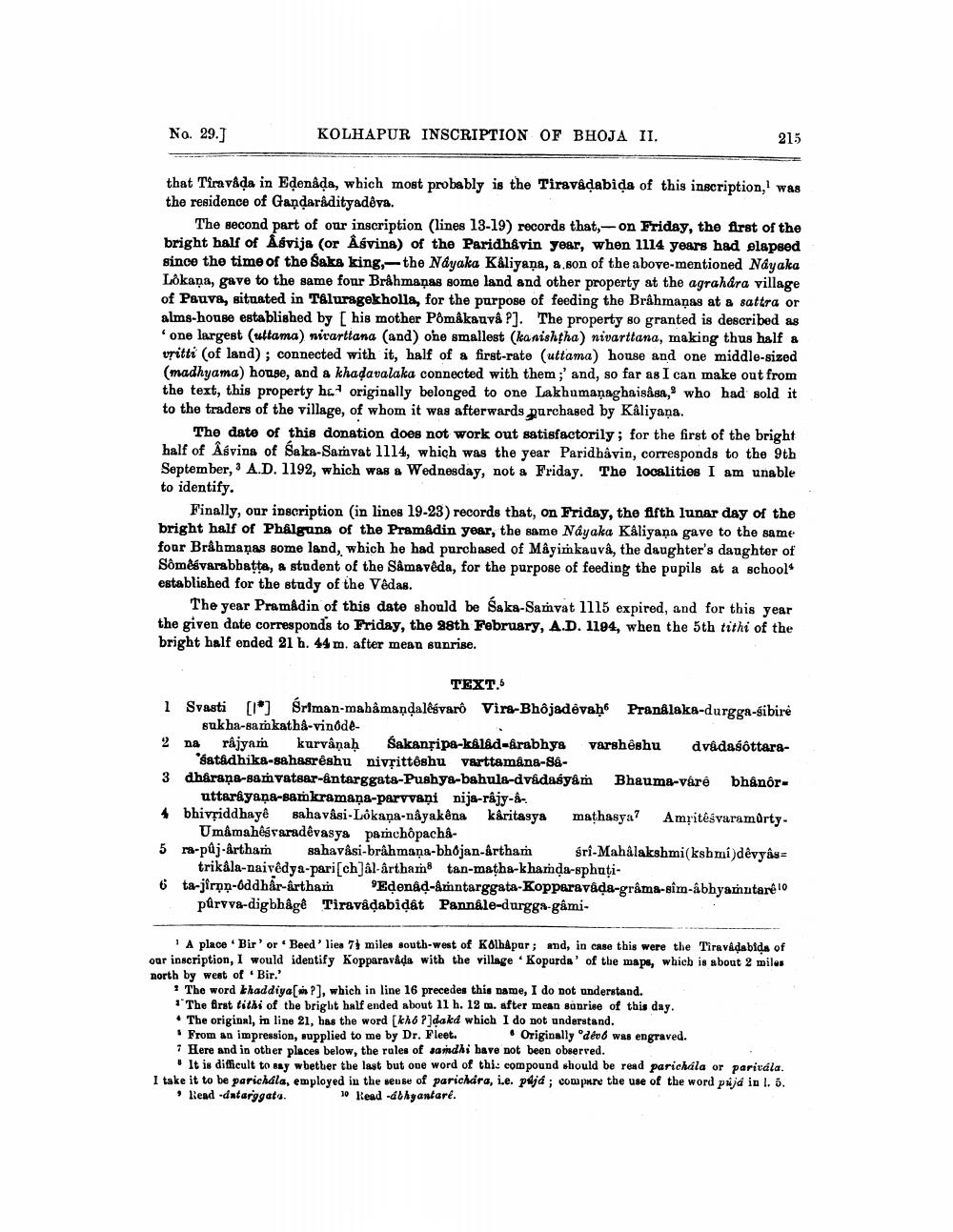________________
No. 29.)
KOLHAPUR INSCRIPTION OF BHOJA II.
215
that Tiravada in Edenada, which most probably is the Tiravadabida of this inscription, was the residence of Gandaradityaddva.
The second part of our inscription lines 13-19) records that,-on Friday, the first of the bright half of Åsvija (or Åsvins) of the Paridhävin year, when 1114 years had elapsed since the time of the Saks king, the Nayaka Kaliyana, &,son of the above-mentioned Nayaka Lôkaņa, gave to the same four Brâhmaņas some land and other property at the agrahára village of Pauva, situated in Taluragekholla, for the purpose of feeding the Brâhmaņas at a sattra or alms-house established by his mother Pômåkauva ?]. The property do granted is described as
one largest (uttama) nirarttana (and) one smallest (kanishtha) nivarttana, making thus half a vritti (of land); connected with it, half of a first-rate (uttama) house and one middle-sized (madhyama) house, and a khadavalaka connected with them;' and, so far as I can make out from the text, this property hu originally belonged to one Lakhumanaghaisasa, who had sold it to the traders of the village, of whom it was afterwards purchased by Kaliyaņa.
The date of this donation does not work out satisfactorily; for the first of the bright half of Åsvins of Saka-Sarvat 1114, which was the year Paridhậvin, corresponds to the 9th September, A.D. 1192, which was a Wednesday, not a Friday. The localities I am unable to identify.
Finally, or inscription in lines 19-23) records that, on Friday, the fifth lunar day of the bright half of Phålguna of the Pramadin year, the same Nayaka Kaliyaņa gave to the same four Brâhmaņas some land, which he had purchased of Mâyimkauva, the daughter's daughter of Sômêsvarabbatta, a student of the Sâmavêda, for the purpose of feeding the pupils at a school established for the study of the Vedas.
The year Pramadin of this date should be Saka-Samvat 1115 expired, and for this year the given date corresponds to Friday, the 28th February, A.D. 1194, when the 5th tithi of the bright half ended 21 h. 44 m. after mean sunrise.
TEXT. 1 Svasti [18] Sriman-mahamandalesvarô Vira-Bhôjadevaḥ Pranalaka-durgga-sibire
sukha-samkathå-vinode2 na rajyam kurvânaḥ Sakansipa-kåled-arabhys varsheshu dvadasóttara
'satadhika-sahasréshu nivșittêshu varttamâna-883 dhåraņa-samvatsar-êntarggata-Pushya-bahula-dvådaśyam Bhauma-våre bhånôr
uttarayaņa-samkramaņa-parvvani nija-rajy-A. 4 bhivriddhaye sahavasi-Lokaņa-nayakéna kåritasya mathasya? Amritésvaramorty
Umamahesvaradêvasya pamchôpachâ5 ra-půj Artham sahavasi-brahmana-bhojan-arthan g ri-Mahalakshmi(kshmi dêvyas
trikala-naivedya-pari [ch]ål-artham tan-matha-khamda-sphati6 ta-jfrnn-oddhår-ártham Edenåd-Amntarggata-Kopparavada-grâma-sam-abhyamntare lo
pûrvva-digbhågê Tiravadabidât Pannale-durgga-gâmi
"A place . Biror Beed’lies 71 miles south-west of Kolhapur; md, in case this were the Tiravadabida of our inscription, I would identify Kopparavada with the village Kopurda' of the maps, whicb is about 2 miles north by west of .Bir.'
The word thaddiya(P), which in line 16 precedes this name, I do not understand. *The first tithi of the bright half ended about 11 h. 12 m. after mean sunrise of this day. • The original, in line 21, bas the word [kho ?]dakd which I do not understand. From an impression, supplied to me by Dr. Fleet.
Originally "dév6 was engraved. 7 Here and in other places below, the rules of sandhi have not been observed.
It is difficult to say wbether the last but one word of this compound should be read parichala or parivala. I take it to be parichala, employed in the sense of parichára, i.e. prija; compare the use of the word prija in l. 5. Read datarggata.
Read -dbhyantare.




